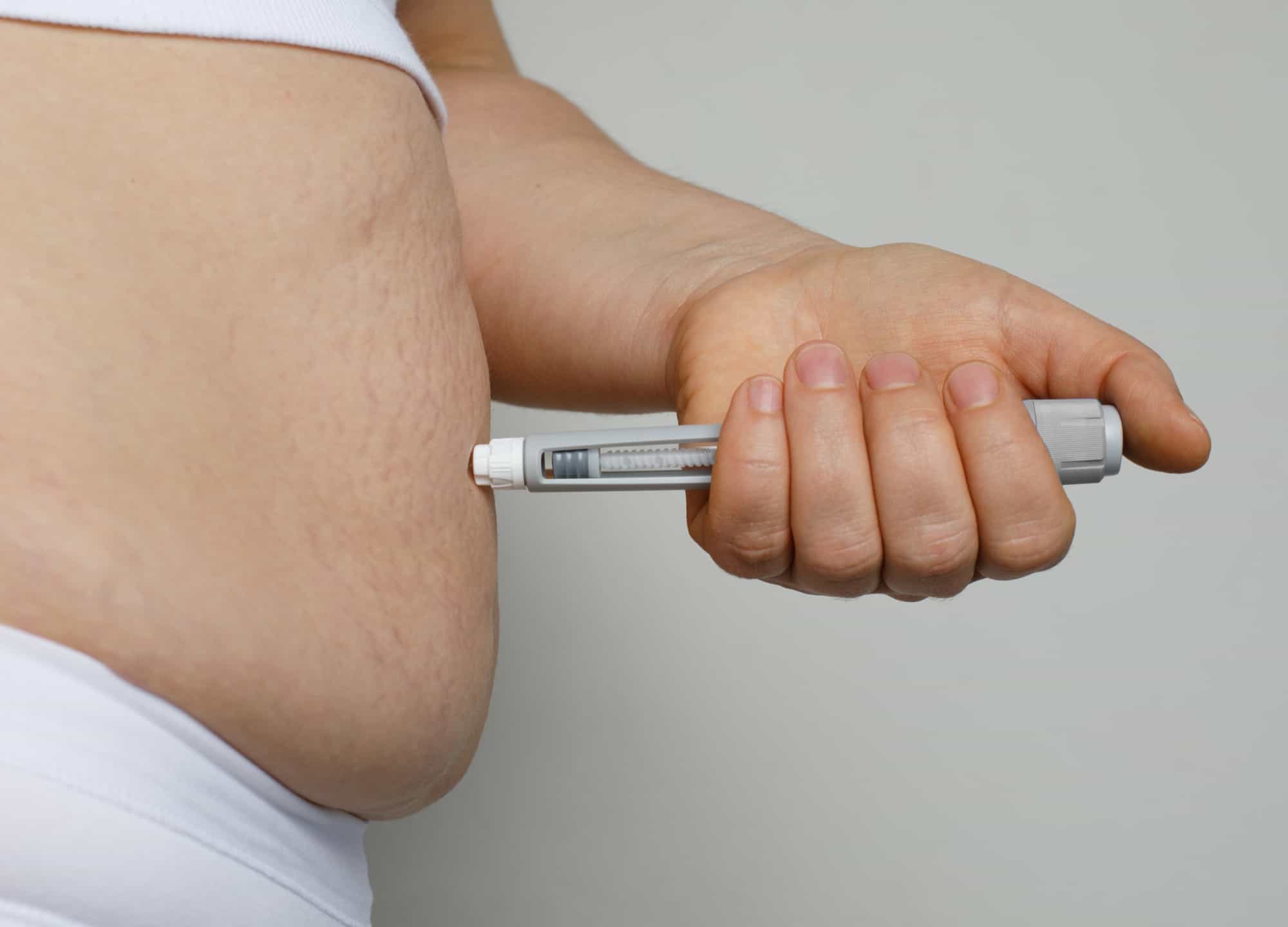Featured Experts
Jamie Gabel, PA-C, medical director at Advitam in New York City
Joe Baczewski, cofounder of LIVation in Madison, Connecticut
Cindy Baczewski, cofounder of LIVation in Madison, Connecticut
Dr. Darren Smith, a board-certified plastic surgeon in New York City
Dr. Caroline Messer, a board-certified endocrinologist of Fifth Avenue Endocrinology and founder of Well by Messer in New York City
If you take the subway, watch TV, listen to podcasts, or even go to a sporting event, you’re likely to come across ads for the ever-popular injectable weight-loss drugs semaglutide (also known as Ozempic or Wegovy) and tirzepatide (Mounjaro or Zepbound). But what you’ve probably not yet heard about is retatrutide. While retatrutide is not yet FDA approved, it should still be on your radar: studies show that retatrutide could be the most powerful drug to be developed in the category. Here’s everything you should know ahead of its FDA approval.
What is retatrutide, and how does it work?
To understand retatrutide, it’s important to get a primer on all three drugs. “All three medications—semaglutide, tirzepatide, and retatrutide—are peptides, or chains of amino acids,” explains Jamie Gabel, PA-C, medical director at Dr. David Shafer’s Advitam in New York City. They are all what are known as incretin mimetics, or GLP-1 agonists. GLP-1 (glucagon-like peptide-1) is a hormone that helps stabilize serum glucose levels. “When done effectively, this alleviates insulin spikes and glucagon spikes, which helps to stabilize hunger cravings and reduce large portions,” explains Joe Baczewski, cofounder of LIVation in Madison, Connecticut. “It also slows down digestion for better breakdown of food and nutrient absorption.”
Of these three drugs, semaglutide is the only one that solely targets your body’s GLP-1 receptor. Tirzepatide also works on the GIP (gastric inhibitory polypeptide) receptor. GIP is similar to GLP-1 but offers additional benefits—this hormone helps to promote muscle regeneration as well as reduce nausea and the likelihood of vomiting. Providers will tell you that it’s crucial to weight train while taking semaglutide, as it can reduce muscle mass; while it’s still important to work out on tirzepatide, it’s not quite as harsh on the muscles. Adds Baczewski, “Semaglutide’s high concentration of GLP-1 can cause gastrointestinal side effects, including nausea, vomiting, constipation, and diarrhea.” Those who have been on both Wegovy and Zepbound often find that the latter is a more comfortable experience. But that may pale in comparison to retatrutide.
“Retatrutide is the first triple agonist, meaning it activates GLP-1, GIP, and glucagon receptors,” explains Dr. Caroline Messer, a board-certified endocrinologist in New York City. While GLP-1 stimulates insulin production to keep your blood sugar from getting too high, glucagon actually creates new glucose to keep it from getting too low (for example, when you’re fasting or working out). This reduces your appetite while also giving you energy. By working on all three receptors at once, retatrutide keeps your blood sugar balanced while keeping you physically comfortable.
How do I take retatrutide?
Retatrutide is injected weekly, just like the other two drugs. “The starting dose is 2 mg, followed by 4 mg, 8 mg, and finally, a maintenance dose of 12 mg,” says Dr. Messer. (This is very similar to the dosing of tirzepatide.) According to Baczewski, the titration schedule is very comparable, though your provider will customize it to your specific needs. “Max dosing is 12 mg, but when being utilized for weight-loss therapy, 4 mg to 6 mg dosing is extremely effective,” Joe adds.
Is retatrutide better than semaglutide or tirzepatide?
The drug that works for you is the best one. “All three medications have demonstrated great results, so I wouldn’t necessarily say one is better than another,” says Gabel. “Many times, what works well for one patient doesn’t work well for another, so having options is a plus.” The Baczewskis confirm this, noting that they start all patients on semaglutide, but if someone doesn’t see results or is experiencing too many uncomfortable side effects, they’ll transition them to tirzepatide. “If they’re still experiencing plateaus in weight loss after achieving max dosing and coaching for proper hydration and eating habits, retatrutide is used as a final option, based on efficacy of therapy,” says Cindy. This is often due to cost (more on this later).
That said, retatrutide may be more clinically effective than its predecessors. “The New England Journal of Medicine published a mid-phase clinical trial looking at 338 adults who were obese or overweight and received either placebo or retatrutide,” says Dr. Messer. “By 48 weeks, patients lost about 24% of their body weight. The weight loss was not only superior to the weight loss seen with other incretins, it also happened more rapidly.”
While we all love near-instant gratification, keep in mind that faster weight loss can lead to undesirable aesthetic side effects. “This will likely continue to drive the uptick in GLP-1–related plastic surgery procedures as patients seek to remove not only excess skin but also manage the additional skin laxity rapid weight loss produces,” points out NYC board-certified plastic surgeon Dr. Darren Smith. Basically, if you were appalled by “Ozempic butt” fear mongering, get ready for the headlines about retatrutide butt.
What are the side effects of retatrutide?
The most common side effects of retatrutide are nausea, constipation, and gastrointestinal upset, the same as with the other GLP-1s. “However, many of the studies I have read thus far suggest decreased severity of these at the lower doses of retatrutide,” Gabel adds. The Baczewskis can speak to this firsthand. “Clients on retatrutide experience many fewer side effects when compared to side effects from other GLP-1 therapies they have tried,” says Joe.
Joe and Cindy aren’t just providers of retatrutide—they use it as well. Joe had seen great success with semaglutide, losing 56 pounds in six months, and was excited to put retatrutide to the test. “I experienced minimal side effects, and my weight loss increased on a lower dose of 4 mg,” he says. Cindy has also tried the medication. “I used it after hitting plateaus with semaglutide,” she explains. “I immediately started losing weight and had fewer side effects—it was very comfortable.” Joe also noticed improved energy levels; if you’ve been on semaglutide and have felt exhausted, you know how major this can be.
While side effects are decreased, they’re still a possibility with retatrutide. But it is worth noting that they’re often a sign that you’re doing things you shouldn’t do when taking a GLP-1. “The side effects we have most commonly seen are constipation, when not drinking enough water with treatment, and diarrhea if one engages in high-fat meals—fatty meat, high butter content, high olive oil content,” says Cindy.
Is retatrutide safe?
Retatrutide is not yet FDA!approved. Eli Lilly (maker of Mounjaro and Zepbound) is currently midway through its phase III clinical trial of retatrutide with the FDA; while it is hard to say when agency approval will be announced, Dr. Messer anticipates that it may be in 2026 or even 2027. “It is only available in a compounded version, and I want to see the phase III trial data before prescribing,” says Dr. Messer. Both Advitam and LIVation offer retatrutide, and both say that getting a reputable source is key to efficacy and safety. The internet has made these types of drugs more accessible than ever before, but where you get your medications from matters. “A patient should be looking to their provider to prescribe medications, not the internet—it can be like the Wild West,” warns Gabel.
Countless people are blindly getting drugs like semaglutide and tirzepatide off the internet without a thorough workup or doing their research, and retatrutide is no exception—but there is a significant risk to taking this kind of shortcut. Many people who do this don’t actually know the source of their drugs. Baczewski notes that he vetted dozens of compounding pharmacies before finding and working with his U.S.-based peptide manufacturer. “A peptide manufacturer is held to a higher level of scrutiny, including third-party testing for purity,” explains Joe. Peptides are often manufactured overseas, with minimal oversight—which is why it was so important to Joe that his peptides were made in the States.
Additionally, without a consultation, a provider may not know important aspects of your medical history that could preclude you from taking GLP-1 drugs, such as a history of pancreatitis. For the best results, a provider will prescribe blood work and analyze your results before prescribing a GLP-1, to make sure there are minimal hidden risks.
What does retatrutide cost?
Compounded semaglutide is often far more affordable than compounded tirzepatide, so it may not come as a surprise that compounded retatrutide is the most expensive of the three options. “There seem to be fewer pharmacies compounding it, which means less volume—the pharmacies are probably paying more for the raw ingredients,” says Gabel. Joe Baczewski confirms this, stating, “As the complexity of the peptide increases, it becomes more expensive to manufacture.”
While prices will vary significantly from provider to provider, a month’s supply of retatrutide at LIVation will run you anywhere from $800 to $2,400, depending on dosing (for context, semaglutide costs $400 to $500). This rate includes coaching and access to LIVation’s medical staff. “If you are getting any of these medications substantially below pricing in your area, I would strongly advise doing your homework,” he adds.











